10 Snakes That Burrow Underground
#mobileSnakeQuizControls { overflow: hidden; text-overflow: ellipsis; white-space: nowrap; }
@media (min-width: 481px) {
.mobile-top-content {
display: none;
}
}
#mobileTopContentCTACarouselControls { overflow: hidden; text-overflow: ellipsis; white-space: nowrap; }
.mobile-top-content .more { color: #fff; }
.mobile-top-content a { color: #fff; text-decoration: underline; }
.mobile-top-content a:hover { color: #fff; text-decoration: underline; }
@media (max-width: 480px) {
.mobile-top-content {
background-color: #06a10b;
color: #fff;
text-align: center;
/*height: 60px;
padding-top:5px;*/
font-size:80%;
/* display: block; */
margin: 0px -30px;
}
}
Most snakes coopt holes that other animals have dug, but some actually burrow underground themselves. Fossorial (burrowing) snakes are good at digging. They burrow to stay safe from predators, stay warm, or even lie in wait for prey. Some studies indicate that fossorial snakes go extinct at a greater rate than non-fossorial snakes.
10. Burrowing Asp
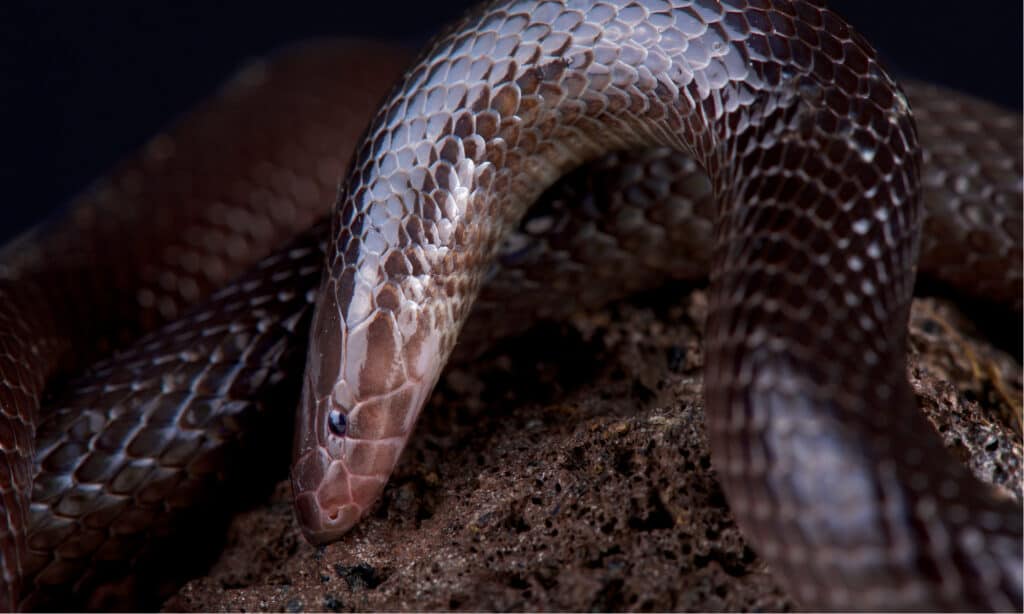
reptiles4all/Shutterstock.com
There is actually an entire genus of snakes known as ‘burrowing asps.’ These snakes live in northern Africa and the Middle East, where they’re often highly feared because of their venom. There are at least 15 species of burrowing asp, though many experts argue that there are more.
button.pulse {
transform: scale(1); animation: pulse 2s infinite;
box-shadow: 0 0 0 0 rgba(11, 247, 25, 1);
}
@keyframes pulse {
0% { transform: scale(0.90); box-shadow: 0 0 0 0 rgba(11, 247, 25, 0.5); }
60% { transform: scale(1); box-shadow: 0 0 0 15px rgba(11, 247, 25, 0); }
100% { transform: scale(0.90); box-shadow: 0 0 0 0 rgba(11, 247, 25, 0); }
}
Burrowing asps are all venomous, and they have the ability to ‘side stab,’ by poking their fangs out the sides of their mouths. Most species are dark brown to black, with small heads. As snakes that burrow underground, most of their diet comes from ground-dwelling small mammals and reptiles.
9. Kirtland’s Snake
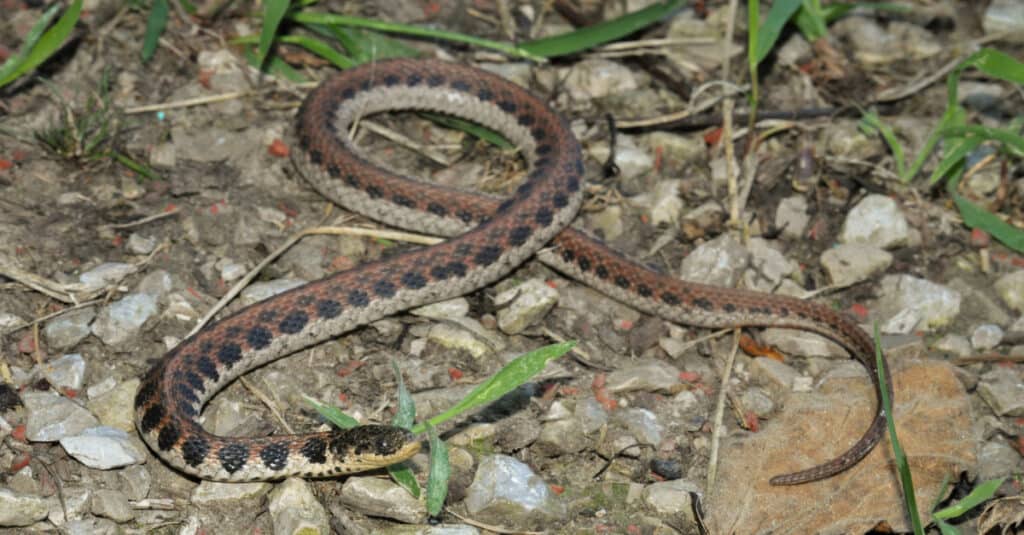
Mike Wilhelm/Shutterstock.com
One of the United States’ snakes that burrow underground, the Kirtland’s snake makes rare appearances. Kirtland’s snakes grow to a maximum length of two feet and spend most of their time hiding in loose soil or under leaf litter. They have orange-red undersides and tan bodies covered in dark, circular markings. Kirtland’s snakes are exceptionally rare and live mostly in wetlands, prairies, and marshes.
8. Sand Boa

iStock.com/PetlinDmitry
One subfamily of snakes that burrow underground comprises species of snakes known as sand boas. Sand boas are related to other boa snakes (like boa constrictors) yet distinct enough from them to merit their own grouping. There are around 15 species of sand boa living in North America, Southeast Asia, Africa, and Europe.
Like all burrowing snakes, sand boas have heads no wider than their necks. They grow to about four feet long for the largest species and have small eyes. As their name suggests, they burrow in the sand, coming out only to ambush prey. Like all boas, sand boas are non-venomous constrictors.
7. South American Striped Blind Snake

Sampaio ILR, Photograph credits: Ivan L. Sampaio (A, B, D, E, H, I), Frederico G. França (F, G, J, L), Pedro T. S. Moura (C) Rafaela C. França (K). Santos CP, França RC, Pedrosa IMMC, Solé M, França FGR (2018) Ecological diversity of a snake assemblage from the Atlantic Forest at the south coast of Paraíba, northeast Brazil. ZooKeys 787: 107-125. https://doi.org/10.3897/zookeys.787.26946 / Creative Commons – License
These snakes that burrow underground are also known as Brongersma’s worm snakes. They’re completely blind and live in Central and South America. Striped blind snakes range in color from light brown to dark brown and grow up to one foot long. Unlike other larger snakes, striped blind snakes eat only insects, mostly termites and ants. They spend most of their lives underground, where they don’t need eyes to see.
6. Trinidad Blind Snake
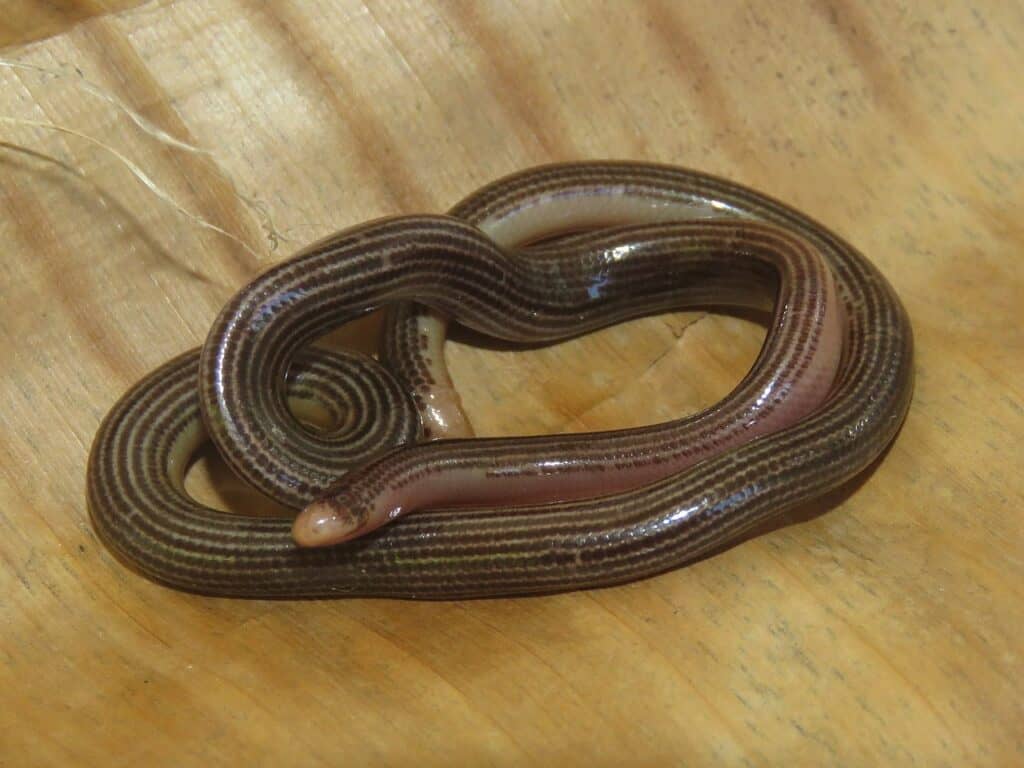
Mike G. Rutherford / Creative Commons – License
Closely related to South American striped blind snakes, Trinidad blind snakes also lack vision. Their eyes are extremely small and useless, and their heads are not differentiated from their necks in any way. Trinidad blind snakes are dark brown with pale pink heads, growing up to two feet long. Like South American striped blind snakes, these snakes that burrow underground live in South and Central America.
5. Worm Snake
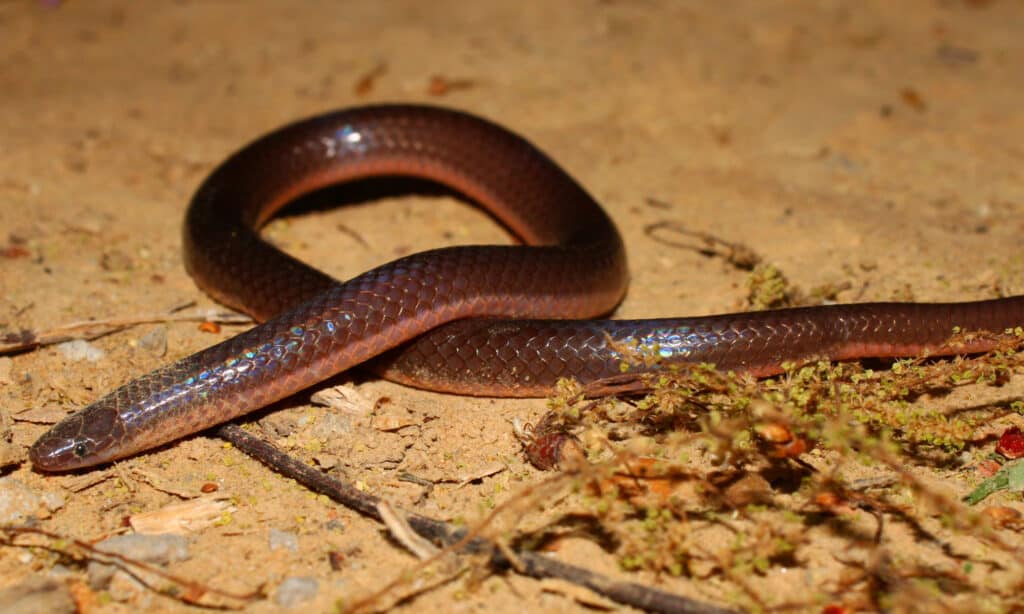
Jason Patrick Ross/Shutterstock.com
In the eastern parts of North America, there lives a tiny, light brown snake. To find this snake, you would have to go poking around in fallen, rotting trees, under leaf litter, and around loose soil. This snake that burrows underground is so small that it’s actually known as the worm snake. Worm snakes have tiny eyes, narrow heads, and slender bodies that grow to no more than one foot in length. They rarely come out into the open, choosing instead to spend most of their time feasting on tiny insects.
4. Brahminy Blind Snakes

Patrick K. Campbell/Shutterstock.com
Though originally from Southeast Asia, these snakes that burrow underground have also taken up residence in the southeastern United States, particularly in Florida, where the heat and humidity agree with them. There’s no need to worry, though; Brahminy blind snakes couldn’t hurt a human if they tried.
One of the most harmless snakes on the planet, Brahminy blind snakes spend their lives hunting underground for ant eggs and pupae. They grow to around one foot long and rarely appear above ground.
3. Black-headed Python
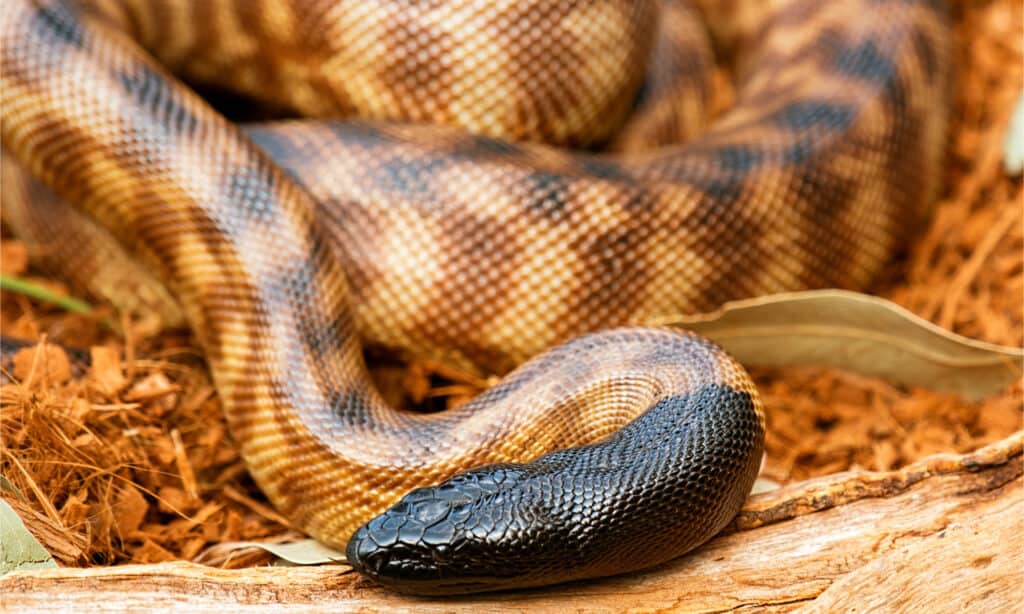
Rob D the Baker/Shutterstock.com
As their name suggests, black-headed pythons have all black heads with tan bodies. They generally grow to around six feet long, though some have grown even longer. These snakes that burrow are native to the northern parts of Australia, where they spend their time in loose soil and rocks. Black-headed pythons may not be venomous, but they eat their fair share of snakes and other reptiles.
2. Woma Python
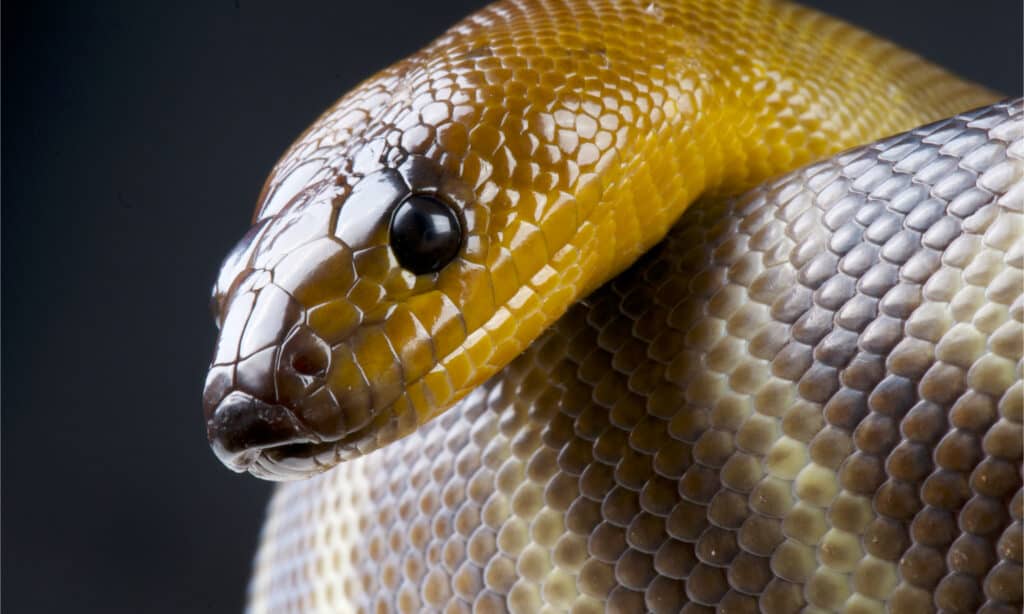
reptiles4all/Shutterstock.com
Like all snakes that burrow underground, Woma pythons have small heads with tiny eyes. They grow to around five feet long, with tan-colored bodies and faint stripes. Woma pythons are native to Australia, where they stick to rotting logs and leaf litter for cover. They eat mainly reptiles but will also eat small mammals if given the chance.
1. Hognose Snake
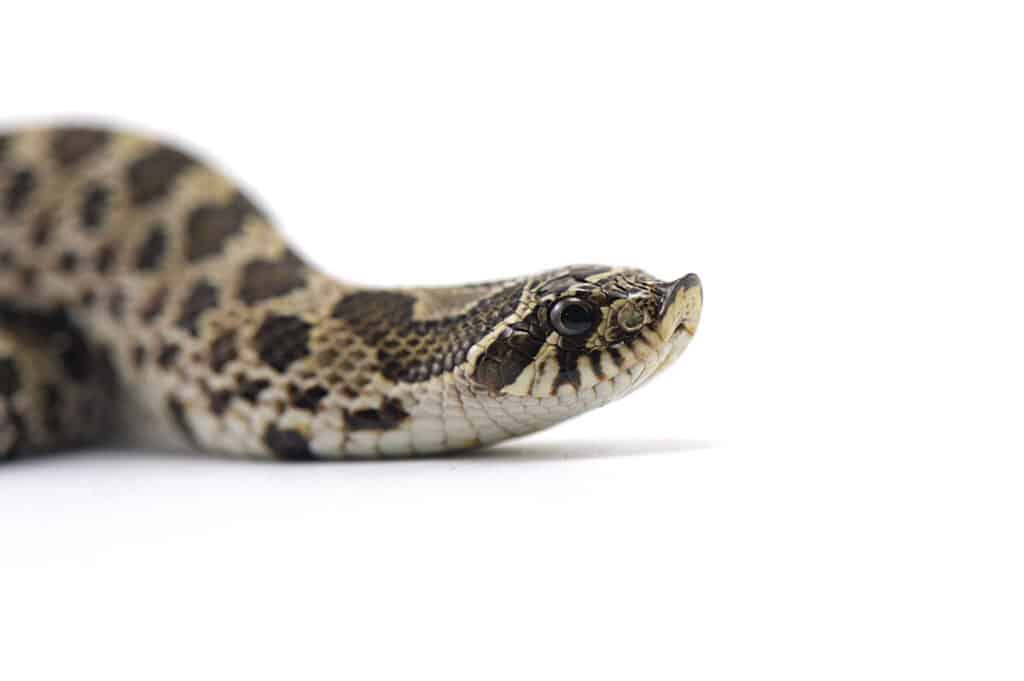
PetlinDmitry/Shutterstock.com
Number one on our list of snakes that burrow underground is the hognose snake, also known as the hog-nosed snake. While the name ‘hognose’ does not refer to one individual species, each species in this genus shares a few common characteristics. These include, most importantly, an upturned, pig-like nose that comes in handy for digging through loose dirt and leafy detritus. Hognose snakes are small, with most measuring under two feet long, and harmless to humans.
Discover the “Monster” Snake 5X Bigger than an Anaconda
Every day A-Z Animals sends out some of the most incredible facts in the world from our free newsletter. Want to discover the 10 most beautiful snakes in the world, a “snake island” where you’re never more than 3 feet from danger, or a “monster” snake 5X larger than an anaconda? Then sign up right now and you’ll start receiving our daily newsletter absolutely free.
More from A-Z Animals
.more-snake-card-image { max-height:140px !important; }
#mobileSnakeQuizControls { overflow: hidden; text-overflow: ellipsis; white-space: nowrap; }
@media (min-width: 481px) {
.mobile-top-content {
display: none;
}
}
#mobileTopContentCTACarouselControls { overflow: hidden; text-overflow: ellipsis; white-space: nowrap; }
.mobile-top-content .more { color: #fff; }
.mobile-top-content a { color: #fff; text-decoration: underline; }
.mobile-top-content a:hover { color: #fff; text-decoration: underline; }
@media (max-width: 480px) {
.mobile-top-content {
background-color: #06a10b;
color: #fff;
text-align: center;
/*height: 60px;
padding-top:5px;*/
font-size:80%;
/* display: block; */
margin: 0px -30px;
}
}
Most snakes coopt holes that other animals have dug, but some actually burrow underground themselves. Fossorial (burrowing) snakes are good at digging. They burrow to stay safe from predators, stay warm, or even lie in wait for prey. Some studies indicate that fossorial snakes go extinct at a greater rate than non-fossorial snakes.
10. Burrowing Asp

reptiles4all/Shutterstock.com
There is actually an entire genus of snakes known as ‘burrowing asps.’ These snakes live in northern Africa and the Middle East, where they’re often highly feared because of their venom. There are at least 15 species of burrowing asp, though many experts argue that there are more.
button.pulse {
transform: scale(1); animation: pulse 2s infinite;
box-shadow: 0 0 0 0 rgba(11, 247, 25, 1);
}
@keyframes pulse {
0% { transform: scale(0.90); box-shadow: 0 0 0 0 rgba(11, 247, 25, 0.5); }
60% { transform: scale(1); box-shadow: 0 0 0 15px rgba(11, 247, 25, 0); }
100% { transform: scale(0.90); box-shadow: 0 0 0 0 rgba(11, 247, 25, 0); }
}
Burrowing asps are all venomous, and they have the ability to ‘side stab,’ by poking their fangs out the sides of their mouths. Most species are dark brown to black, with small heads. As snakes that burrow underground, most of their diet comes from ground-dwelling small mammals and reptiles.
9. Kirtland’s Snake

Mike Wilhelm/Shutterstock.com
One of the United States’ snakes that burrow underground, the Kirtland’s snake makes rare appearances. Kirtland’s snakes grow to a maximum length of two feet and spend most of their time hiding in loose soil or under leaf litter. They have orange-red undersides and tan bodies covered in dark, circular markings. Kirtland’s snakes are exceptionally rare and live mostly in wetlands, prairies, and marshes.
8. Sand Boa

iStock.com/PetlinDmitry
One subfamily of snakes that burrow underground comprises species of snakes known as sand boas. Sand boas are related to other boa snakes (like boa constrictors) yet distinct enough from them to merit their own grouping. There are around 15 species of sand boa living in North America, Southeast Asia, Africa, and Europe.
Like all burrowing snakes, sand boas have heads no wider than their necks. They grow to about four feet long for the largest species and have small eyes. As their name suggests, they burrow in the sand, coming out only to ambush prey. Like all boas, sand boas are non-venomous constrictors.
7. South American Striped Blind Snake

Sampaio ILR, Photograph credits: Ivan L. Sampaio (A, B, D, E, H, I), Frederico G. França (F, G, J, L), Pedro T. S. Moura (C) Rafaela C. França (K). Santos CP, França RC, Pedrosa IMMC, Solé M, França FGR (2018) Ecological diversity of a snake assemblage from the Atlantic Forest at the south coast of Paraíba, northeast Brazil. ZooKeys 787: 107-125. https://doi.org/10.3897/zookeys.787.26946 / Creative Commons – License
These snakes that burrow underground are also known as Brongersma’s worm snakes. They’re completely blind and live in Central and South America. Striped blind snakes range in color from light brown to dark brown and grow up to one foot long. Unlike other larger snakes, striped blind snakes eat only insects, mostly termites and ants. They spend most of their lives underground, where they don’t need eyes to see.
6. Trinidad Blind Snake

Mike G. Rutherford / Creative Commons – License
Closely related to South American striped blind snakes, Trinidad blind snakes also lack vision. Their eyes are extremely small and useless, and their heads are not differentiated from their necks in any way. Trinidad blind snakes are dark brown with pale pink heads, growing up to two feet long. Like South American striped blind snakes, these snakes that burrow underground live in South and Central America.
5. Worm Snake

Jason Patrick Ross/Shutterstock.com
In the eastern parts of North America, there lives a tiny, light brown snake. To find this snake, you would have to go poking around in fallen, rotting trees, under leaf litter, and around loose soil. This snake that burrows underground is so small that it’s actually known as the worm snake. Worm snakes have tiny eyes, narrow heads, and slender bodies that grow to no more than one foot in length. They rarely come out into the open, choosing instead to spend most of their time feasting on tiny insects.
4. Brahminy Blind Snakes

Patrick K. Campbell/Shutterstock.com
Though originally from Southeast Asia, these snakes that burrow underground have also taken up residence in the southeastern United States, particularly in Florida, where the heat and humidity agree with them. There’s no need to worry, though; Brahminy blind snakes couldn’t hurt a human if they tried.
One of the most harmless snakes on the planet, Brahminy blind snakes spend their lives hunting underground for ant eggs and pupae. They grow to around one foot long and rarely appear above ground.
3. Black-headed Python

Rob D the Baker/Shutterstock.com
As their name suggests, black-headed pythons have all black heads with tan bodies. They generally grow to around six feet long, though some have grown even longer. These snakes that burrow are native to the northern parts of Australia, where they spend their time in loose soil and rocks. Black-headed pythons may not be venomous, but they eat their fair share of snakes and other reptiles.
2. Woma Python

reptiles4all/Shutterstock.com
Like all snakes that burrow underground, Woma pythons have small heads with tiny eyes. They grow to around five feet long, with tan-colored bodies and faint stripes. Woma pythons are native to Australia, where they stick to rotting logs and leaf litter for cover. They eat mainly reptiles but will also eat small mammals if given the chance.
1. Hognose Snake

PetlinDmitry/Shutterstock.com
Number one on our list of snakes that burrow underground is the hognose snake, also known as the hog-nosed snake. While the name ‘hognose’ does not refer to one individual species, each species in this genus shares a few common characteristics. These include, most importantly, an upturned, pig-like nose that comes in handy for digging through loose dirt and leafy detritus. Hognose snakes are small, with most measuring under two feet long, and harmless to humans.
Discover the “Monster” Snake 5X Bigger than an Anaconda
Every day A-Z Animals sends out some of the most incredible facts in the world from our free newsletter. Want to discover the 10 most beautiful snakes in the world, a “snake island” where you’re never more than 3 feet from danger, or a “monster” snake 5X larger than an anaconda? Then sign up right now and you’ll start receiving our daily newsletter absolutely free.







